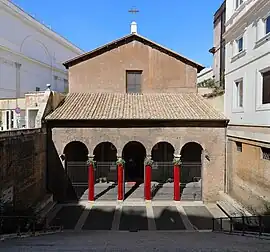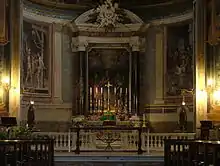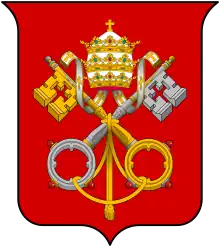San Vitale, Rome
The early Christian imperial basilica of the Saints Martyrs Vitale, Valeria, Gervasio and Protasio known more commonly as the basilica of San Vitale and Compagni Martiri in Fovea (Roman Parish) or more simply as San Vitale al Quirinale. It is the oldest Catholic place of worship in the historic center of Rome, located in via Nazionale. The imperial basilica of San Vitale al Quirinale, built under the pontificate of Pope Siricius after 386 and consecrated and richly decorated by Pope Innocent in 402 (Luigi Hutter and Vincenzo Golzino) is the first public Christian basilica with a baptistery (still not found) not founded on pre-existing pagan temples, mentioned in the Liber pontificalis, built by the Emperor Theodosius at the behest of Saint Ambrose of Milan, in honor of the miraculous discovery of the bodies of martyrs Gervasius and Protasius in Milan. It is the most frescoed basilica in Rome.
| Basilica of Sts. Vitalis, Valeris, Gervase and Protase | |
|---|---|
| Basilica Ss. Vitalis, Valeriae, Gervasii et Protasii(in Latin) | |
Basilica di Santi Vitale e Compagni Martiri in Fovea(in Italian) | |
 Façade of the Basilica of San Vitale | |
Click on the map for a fullscreen view | |
| 41°53′58.8″N 12°29′27.1″E | |
| Location | Via Nazionale 194/B, Rome |
| Country | Italy |
| Denomination | Roman Catholic |
| Tradition | Roman Rite |
| Website | Official website |
| History | |
| Status | Minor basilica, titular church |
| Dedication | Vitalis of Milan, Valeria of Milan, Gervasius and Protasius |
| Consecrated | AD 401 |
| Architecture | |
| Architectural type | Church |
| Style | Paleochristian |
| Groundbreaking | ca. 400 |
| Specifications | |
| Length | 60 metres (200 ft) |
| Width | 18 metres (59 ft) |
| Clergy | |
| Cardinal protector | Adam Maida |
History
The basilica was built in 400 with funds provided by Vestina, a wealthy widow,[1] and was consecrated by Pope Innocent I in 401/402. It was dedicated to Ss. Gervasius and Protasius, and called the "titulus Vestinae". The dedication to St. Vitalis and his family (Saint Valeria, his wife, and Sts. Gervasius and Protasius, their sons) is dated to 412.[2] This church is recorded as Titulus Vestinae in the acts of the 499 synod of Pope Symmachus, and three priests from the church subscribed their names.[3]
San Vitale was restored several times, most importantly when it was extensively rebuilt by Pope Sixtus IV before the Jubilee of 1475.[4] Other interventions took place in 1512 under Cardinal del Monte;[5] in 1598, in 1859 by the generosity of Pope Pius IX;[6] in 1938 and 1960. Because of changes in the city over the centuries, the floor level of the church is now several metres below the level of the street on which it is located, the present-day via Nazionale.
Customs
Free bread was distributed to the poor by the church every Friday, according to the will of a gentleman from the Marches, Francesco Silla.[7]
Architectural and Artistic Features
Exterior
The portico is the most ancient part of the church, possibly dating back to the 5th century. It was altered at the end of the 16th century. The inscription on the portico, with the arms of Pope Sixtus IV, dates from this time. Pope Pius IX built the staircase to the 5th century portico in 1859.
Interior

The church has a single nave, with walls frescoed with scenes of martyrdom, among which a Martyrdom of St Ignatius of Antioch, in which a ruined Colosseum is depicted. The apse, a surviving part of the original 5th century church, is decorated with a fresco by Andrea Commodi, The Ascent to Calvary.
Cardinal Priests
Among the cardinals who previously took their title from the church were: John Fisher, executed for treason in 1535 by Henry VIII of England; and Giovanni Maria Ciocchi del Monte, who became Pope Julius III (1550–1555). The titulus was suppressed by Pope Clement VIII in 1596. It was united with the nearby Jesuit church of S. Andrea.[8]
The titulus was restored by Pope Leo XIII in 1880, with the appointment of Cardinal Andon Bedros IX Hassoun. The current Cardinal Priest is Cardinal Adam Maida.
- Caelius Januarius (attested 499)[9]
- ...
- Lictifredus (attested 1128–1130; 1133–1140)[10]
- Matthaeus (1130)
- Thomas (1141–1146)
- Theodinus (1166–1179)[11]
- ...
- Gregorius (1202–1207)[12]
- Joannes de Castrocoeli (1294–1295)
- Petrus de Capella (1305–1306)[13]
- Jacques Duèse (1312–1313)
- Bertrand de la Tour, O.Min . (1320–1323)
- Joannes de Convenis (Jean de Comminges) (1327–1331)
- Elias de Nabinalis, O.Min. (1342–1348)
- Nicolaus Capocci (1350–1361)[14]
- Guillaume de Chanac, O.S.B. (1371–1383)
- Jean de Muriolo (Murol) (1385–1399) (Avignon Obedience)[15]
- Peter von Schaumberg (1440−1469)[16]
- Ausiàs Despuig (1473–1477)[17]
- Cristoforo della Rovere (1477–1478)[18]
- Domenico della Rovere (1478–1479)[19]
- Ferry de Clugny (1480–1482)[20]
- Joan Margarit i Pau (1483–1484)[21]
- Giovanni Conti (1489–1493)[22]
- Raymond Peraudi (1496–1499)[23]
- Jaime Serra i Cau (1500–1502)[24]
- Gianstefano Ferrero (1502–1505)[25]
- Antonio Ferrero (1505–1508)[26]
- René de Prie (1509–1511)[27]
- Antonio Maria Ciocchi del Monte (1511–1514)[28]
- Francesco Conti (1517–1521)[29]
- Marino Grimani (1528–1532)[30]
- Esteban Gabriel Merino (1533–1534)[31]
- John Fisher (1535)[32]
- Gasparo Contarini (1535–1537)[33]
- Giovanni Maria Ciocchi del Monte (1537–1542)[34]
- Giovanni Morone (1542–1549)[35]
- Filiberto Ferrero (1549)[36]
- Giovanni Ricci (1551–1566)[37]
- Luigi Pisani (1566–1568)[38]
- Luigi Cornaro (1568–1569)[39]
- Gaspar Cervantes (June 1570)[40]
- Pietro Donato Cesi (1570–1584)[41]
- Costanzo da Sarnano, O.Min.Conv. (1587)[42]
- Antonio Sauli (1588–1591).[43]
Restored title
- Andon Bedros IX Hassoun (1880–1884)[44]
- Guglielmo Massaia, O.F.M.Cap. (1884–1889)[45]
- Albin Dunajewski (1891–1894)[46]
- Jan Puzyna de Kosielsko (1902–1911)[47]
- Louis-Nazaire Bégin (1914–1925)[48]
- Vicente Casanova y Marzol (1925–1930)[49]
- Karel Kašpar (1935–1941)[50]
- Manuel Arce y Ochotorena (1946–1948)[51]
- Benjamín de Arriba y Castro (1953–1973)[52]
- František Tomášek (1977–1992)[53]
- Adam Maida (1994–present)[54]
References
- David Hunt, Chapter VIII of The Cambridge Ancient History, Volume XIII, p.251
- Mariano Armellini, le chiese di Roma, dalle loro origine sino al secolo XVI (Roma: Tip. ed. Romana 1887), pp. 244-245.
- J.D. Mansi (ed.), Sacrorum Conciliorum nova et amplissima collectio, editio novissima, Tomus VIII (Florence: A. Zatta 1762), p. 236.
- Forcella XI, p. 221, no. 356.
- Forcella XI, p. 221, no. 357.
- Forcella XI, p. 222, no. 358.
- Armellini, p. 245. Silla was a notary, and served as private secretary to Cardinal Guglielmo Sirleto (1514-1585).
- Gauchat, p. 50. Forcella XI, p. 219.
- Caelius Januarius subscribed the acts of the Roman synod of Pope Gelasius II in 499. Mansi (ed.) VIII, p. 236: "Caelius Januarius Presbyter tituli Vestinae his consensi et subscripsi synodalibus constitutis, atque in hac ... manere profiteor sententia." The document is also signed by Soranus, presbyter tituli Vestinae, and Opilio, presbyter tituli Vestinae.
- J. Brixius, p. 36, 146. Lictifredus joined the Obedience of Anacletus II in 1130, and was replaced by Matthaeus of the Obedience of Innocent II (1130–1133).
- Brixius, pp. 66, 146.
- C. Eubel, Hierarchia catholica, 2nd ed. (Münster: Typ. Lib. Regensbergianae 1913) I, pp. 3, note 1, no. 23; 48. Gregorius Crescenzi had earlier been Cardinal deacon of S. Maria in Aquiro (1188–1202).
- Pierre de la Chapelle Taillefert, bishop of Toulouse. Eubel I, p. 48.
- Nicolaus was promoted Cardinal Bishop of Tusculum (1361–1368). Eubel I, pp. 38, 48.
- Eubel I, pp. 28, no. 24; 48.
- Schaumberg was bishop of Augsburg. Eubel II, p. 8; p. 36, no. 289; p. 65.
- Despuig was archbishop of Monreale in Sicily. He was transferred to the titular church of Santa Sabina on 12 December 1477. Eubel II, pp. 17 no. 5; 65.
- Della Rovere was a nephew of Pope Sixtus IV. He died on 1 February 1478. Eubel II, pp. 18 no. 16; 65.
- Domenico was the brother of Cristoforo. He was transferred to the church of San Clemente on 13 August 1479. Eubel II, pp. 18 no. 23; 65.
- Ferry was transferred to Santa Maria in Domnica. He died on 7 October 1483. Eubel II, pp. 19 no. 26; 65.
- Margarit was the ambassador of the king of Castile to the pope. On 17 March 1484, Margarit was transferred to the church of Santa Balbina. He died on 21 November 1484. Eubel II, pp. 19 no. 31; 65.
- Eubel II, pp. 19 no. 29; 65.
- Eubel II, pp. 22 no. 10; 65.
- Serra was transferred to the church of San Clemente on 28 June 1502. Eubel II, pp. 24 no. 25; 65.
- Ferrero was transferred to the church of Santi Sergio e Bacco al Foro Romano on 17 December 1505. He died in 1510. Eubel II, pp. 24 no. 34; 65. Eubel III, p. 71.
- Ferrero: Eubel III, pp. 10 no. 8; 71.
- De Prie was transferred to the titular church of Santa Sabina on 17 March 1511. Eubel III, pp. 11 no. 15; 71.
- Del Monte was transferred to the titular church of Santa Prassede on 14 July 1514. Eubel III, pp. 12 no. 20; 71.
- Eubel III, pp. 15 no. 9; 71.
- Grimani was transferred to the titular church of San Marcello al Corso on 12 November 1532. Eubel III, pp. 19 no. 5; 71.
- Merino was transferred to the titular church of Santi Giovanni e Paolo al Celio on 5 September 1534. Eubel III, pp. 21 no. 28; 71.
- Fisher, who was imprisoned in the Tower of London, was named cardinal on 31 May 1535, and died on 22 June 1535. Eubel III, pp. 24 no. 6; 71.
- Contarini was transferred to the titular church of Santa Balbina on 15 January 1537. Eubel III, pp. 24 no. 8; 71.
- Eubel III, pp. 24 no. 11; 31; 71.
- Morone was transferred to the titular church of San Stefano on 25 February 1549. Eubel III, pp. 27 no. 40; 71.
- Ferrero died on 14 August 1549. Eubel III, pp. 31 no. 70; 71.
- Ricci: Eubel III, pp. 32 no. 6; 71.
- Pisani was transferred to the titular church of San Marco on 2 June 1568. Eubel III, pp. 40 no. 29; 71.
- Cornaro was transferred to the titular church of San Clemente on 9 February 1569. Eubel III, pp. 33 no. 15; 71.
- Cervantes was appointed on 9 June, and transferred on 16 June to San Martino ai Monti. Eubel III, pp. 44 no. 7; 71.
- Cesi: Eubel III, pp. 44 no. 9; 71.
- 14 January to 20 April 1587. Eubel III, pp. 51 no. 14; 71.
- Eubel III, pp. 52 no. 20; 71.
- Bräuer, p. 121.
- Bräuer, p. 130.
- Bräuer, p. 153.
- Bräuer, p. 193.
- Bräuer, p. 223.
- Bräuer, p. 261.
- Bräuer, p. 287.
- Bräuer, p. 313.
- Bräuer, p. 331.
- Bräuer, p. 379.
- Bräuer, p. 566.
Bibliography
- Armellini, Mariano (1891). Le chiese di Roma dal secolo IV al XIX (in Italian). Roma: Edizioni del Pasquino. pp. 187–189.
- Bräuer, Martin (2014). Handbuch der Kardinäle: 1846-2012 (in German). Berlin: De Gruyter. ISBN 978-3-11-026947-5.
- Eubel, Conradus, ed. (1913). Hierarchia catholica (in Latin). Vol. Tomus 1 (second ed.). Münster: Libreria Regensbergiana. (in Latin)
- Eubel, Conradus, ed. (1914). Hierarchia catholica (in Latin). Vol. Tomus 2 (second ed.). Münster: Libreria Regensbergiana.
- Gulik, Guilelmus (1923). Eubel, Conradus (ed.). Hierarchia catholica (in Latin). Vol. Tomus 3 (second ed.). Münster: Libreria Regensbergiana.
- Forcella, Vencenzo (1877). Le inscrizioni delle chiese e d'altri edifici di Roma Volume XI (Roma: L. Cecchini 1877). (in Latin and Italian)
- Gauchat, Patritius (Patrice) (1935). Hierarchia catholica. Vol. Tomus IV (1592-1667). Münster: Libraria Regensbergiana.
- Krautheimer, Richard; Spencer Corbett; Volfango Frankl (1970). Corpus basilicarum Christianarum Romae: Le basiliche cristiane antiche di Roma. Monumenti di antichità cristiana : ser. 2, v. 2. Citta del Vaticano: Pontificio istituto di archeologia cristiana. pp. 313 ff.
External links
![]() Media related to San Vitale (Rome) at Wikimedia Commons
Media related to San Vitale (Rome) at Wikimedia Commons
| Preceded by Santa Teresa, Rome |
Landmarks of Rome San Vitale, Rome |
Succeeded by Casa dei Cavalieri di Rodi |
